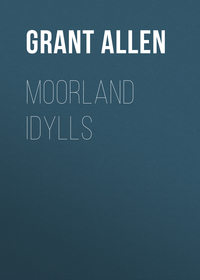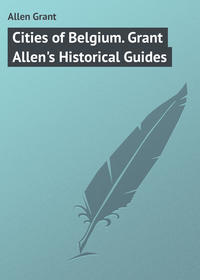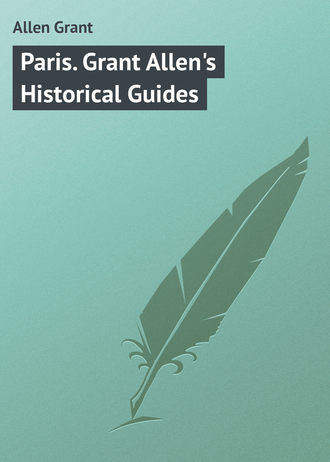 полная версия
полная версияParis. Grant Allen's Historical Guides
By far the most interesting object in the interior, however, is the series of **high reliefs in stone, gilt and painted (on the wall between choir and ambulatory), executed early in the 14th century by Jehan Ravy and his nephew, Jehan de Bouteillier, which, though inferior in merit to those in the same position in Amiens cathedral, are admirable examples of animated and vigorous French sculpture of their period. The series begins on the N side of the choir, at the point most remote from the grill which leads to the Transept. The remaining subjects (for some, like the Annunciation, are destroyed) comprise the Visitation; Adoration of the Shepherds; Nativity; Adoration of the Magi (note the Three Kings, representing the three ages of man; the oldest, as usual, has removed his crown, and is offering his gift); the Massacre of the Innocents; the Flight into Egypt (where a grotesque little temple, containing two odd small gods, quaintly represents the prevalence of idolatry); the Presentation in the Temple; Christ among the Doctors; the Baptism in Jordan (with attendant angel holding a towel); the Miracle at Cana; the Entry into Jerusalem (with Zacchæus in the tree, and the gate of the city); the Last Supper; the Washing of the Apostles’ feet; and the Agony in the Garden. The tourist should carefully examine all these subjects, the treatment of which strikes a keynote. Similar scenes, almost identical in their figures, will be found in abundance at Cluny and elsewhere. Note, for example, the symbolical Jordan in the Baptism, with St. John pouring water from a cup, and the attendant angel, all of which we shall often recognise hereafter.
The series is continued on the other (S) side of the choir (a little later in date, with names in Latin underneath; better modelled, but neither so quaint nor so vigorous). The subjects begin by the grill of the South Transept, with the “Noli me tangere” or Apparition to Mary Magdalen (Christ as a gardener); the Apparition to the Marys; to Simon Peter; to the Disciples at Emmaus (dressed as mediæval pilgrims); to the Eleven Apostles; to the Ten and Thomas; to the Eleven by the sea of Tiberias; to the Disciples in Galilee; and on the Mount of Olives. The intervening and remaining subjects – Scourging, Crucifixion, Ascension, etc. – were ruthlessly destroyed by Louis XIV, in order to carry out his supposed improvements in accordance with the vow of his father, Louis XIII. The woodwork of the choir-stalls, executed by his order, is celebrated, and uninteresting. You may omit it. The Treasury contains little of artistic value. The Crown of Thorns still figures in its inventory.
Leave the Choir by the door by which you entered it, and seat yourself for a while at the intersection of the Nave and Transepts, in order to gain a good idea of the Apse, the Choir, and the general arrangement of the shortly cruciform building. Observe the beautiful vaulting of the roof, and the extent to which the church is born on its piers alone, the intervening walls (pierced by windows and triforium-arches) being intended merely for purposes of enclosure. Note also the fine ancient glass of the rose windows. Quit the church by the North or Left Aisle, and come back to it often.
Those who are not afraid of a spiral staircase, mostly well lighted, should ascend the Left or North Tower (tickets fifty cents. each, at the base of the tower). Stop near the top to inspect the gallery, with the famous birds and demons. The view hence embraces from the front the Tower of St. Jacques; behind it, the hill of Montmartre, with the white turrets and cupolas of the church of the Sacré-Cœur; a little to the L, St. Eustache; then the Tribunal de Commerce; St. Augustin; the Louvre; the roof of the Ste. Chapelle; the Arc de Triomphe; the twin towers of the Trocadéro; the Eiffel Tower; the gilded dome of the Invalides; St. Sulpice, etc. The Île de la Cité is well seen hence as an island. Note also the gigantic size of the open screen, which looked so small from below. Ascend to the top. Good general panorama of the town and valley. This is the best total view of Paris, far superior to that from the Eiffel Tower, being so much more central.
Return by the Pont d’Arcole (whence you get a capital notion of the bifurcation of the Seine around the Île St. Louis), and then pass the modern Hôtel-de-Ville, with St. Gervais behind it, on your way home to the Rue de Rivoli.
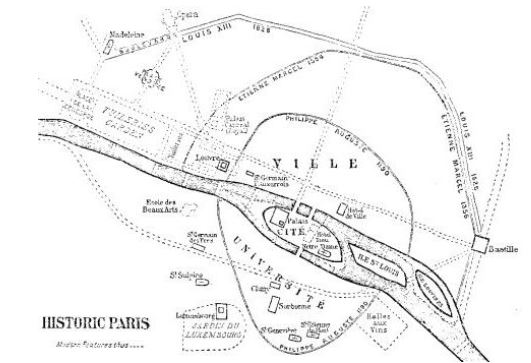
[Map of] HISTORIC PARIS
MAP OF HISTORIC PARIS
This Map represents approximately the growth of Paris, outside the island, at different epochs. Earlier buildings are printed in black; later streets and edifices are shown by means of dotted lines. But the Map does not represent the aspect of Paris at any one time; it merely illustrates this Guide: thus, the original Château of the Louvre is marked in black; the later Palace is dotted; whereas the Madeleine, a much more modern building than the Louvre of François I, is again inserted in black, because it does not interfere with the site of any more ancient building. In very early times the town spread south as far only as Cluny, and north (just opposite the island) as far as the Rue de Rivoli. The subsequent walls are marked approximately on the Map, with the chief edifices enclosed by them. The fortifications of Louis XIII were demolished by Louis XIV, who substituted for them the broad streets still known as the Boulevards. This Map shows, roughly speaking, the extent of Paris under Louis XIV; by comparing it with Baedeker’s Map of Modern Paris, the small relative size of the 17th-century town will be at once appreciated. Nevertheless, the inner nucleus here mapped out contains almost everything worthy of note in the existing city.
II
THE LEFT OR SOUTH BANK
[THE earliest overflow of Paris was from the Île de la Cité to the Left or South Bank (Rive Gauche).
The reason for this overflow is clear. The city was situated on a small island, near the head of navigation; it guarded the passage of the Seine by the double bridge. Naturally, however, at a time when all civilization lay to the south, as the town began to grow, it spread southward, towards Rome, Lyons, Marseilles, Bordeaux, Toulouse, Arles, Nîmes, and the Roman culture. To the north at that time lay nothing but comparative barbarism – the Britons and the Germans; or later, the English, the Normans, and the Teutonic hordes. Hence, from a very early date, Paris first ran southward along the road to Rome. Already in Roman times, here stood the palace of Constantius Chlorus and Julian, now the Thermes – the fortress which formed the tête du pont for the city. Later, the southern suburb became the seat of learning and law; it was known by the name which it still in part retains of the Université, but is oftener now called the Quartier Latin. At first, however, only a small portion of the Left Bank was built over. But gradually the area of the new town spread from the immediate neighbourhood of the old Hôtel-Dieu, with its church or chapel of St. Julien-le-Pauvre, to the modern limit of the Boulevard St. Germain; and thence again, by the time of Louis Quatorze, to the further Boulevards just south of the Luxembourg. It is interesting to note, too, that all this southern side, long known as the Université, still retains its position as the learned district. Not only does it include the students’ region – the Quartier Latin – with many of the chief artistic studios, but it embraces in particular the Sorbonne, or University, the Institute of France, with its various branches (Académie Française, Académie des Inscriptions et Belles-Lettres, Académie des Sciences, des Beaux-Arts, etc.), the École des Beaux-Arts, the École de Médicine, the Collège de France, the Lycées St. Louis, Louis-le-Grand, and Henri IV, the École Polytechnique, the École des Mines, the Bibliothèque Ste. Geneviève, the Jardin des Plantes, and the Luxembourg Museum of Modern Paintings. In short, the Left Bank represents literary, scientific, artistic, and educational Paris – the students in law, arts, and medicine, with their own subventioned theatre, the Odéon, and their libraries, schools, laboratories, and cafés. It is further noticeable that these institutions cluster thickest round the older part of the southern suburb, just opposite the Cité, while almost all of them lie within the limits of the outer boulevards of Louis XIV.
The Quartier Latin surrounds the Sorbonne, and is traversed by the modern Boulevard St. Michel. The Faubourg St. Germain, immediately to the west of it (surrounding the old Abbey of St. Germain-des-Prés) is of rather later date; it owes its origin in large part to the Renaissance spirit, and especially to Marie de Médicis’ palace of the Luxembourg. It is still the residence of many of the old nobility, and is regarded as the distinctively aristocratic quarter of Paris, in the restricted sense, while the district lying around the Champs Élysées is rather plutocratic and modern than noble in the older signification of the word.
The visitor will therefore bear in mind distinctly that the South Side is the Paris of the Students.]
A. THE ROMAN PALACE AND THE
MUSÉE DE CLUNY
[The primitive nucleus of the suburb on the South Side consists of the Roman fortress palace, the tête du pont of the Left Bank, now known as the Thermes, owing to the fact that its principal existing remains include only the ruins of the baths or thermæ. This colossal building, probably erected by Constantius Chlorus, the father of Constantine, covered an enormous area south of the river. After the Frankish conquest, it still remained the residence of the Merwing and Karling kings on the rare occasions when they visited Paris; and it does not seem to have fallen into utter decay till a comparatively late date in the Middle Ages. With the Norman irruptions, however, and the rise of the real French monarchs under Eudes and the Capets, the new sovereigns found it safest to transfer their seat to the Palace on the Island (now the Palais de Justice), and the Roman fortress was gradually dismantled. In 1340 the gigantic ruins came into the hands of the powerful Benedictine Abbey of Cluny, near Mâcon, in Burgundy; and about 1480, the abbots began to erect on the spot a town mansion for themselves, which still bears the name of the Hôtel de Cluny. The letter K, the mark of Charles VIII (1483–1498), occurs on many parts of the existing building, and fixes its epoch. The house was mostly built by Jacques d’Amboise, abbot, in 1490. The style is late Gothic, with Renaissance features. The abbots, however, seldom visited Paris, and they frequently placed their town house accordingly at the disposition of the kings of France. Mary of England, sister of Henry VIII, and widow of Louis XII, occupied it thus in 1515, soon after its completion. It was usual for the queens of France to wear white as mourning; hence her apartment is still known as the Chambre de la reine blanche.
At the Revolution, when the property of the monasteries was confiscated, the Hôtel de Cluny was sold, and passed at last, in 1833, into the hands of M. du Sommerard, a zealous antiquary, who began the priceless collection of works of art which it contains. He died in 1842, and the Government then bought the house and museum, and united it with the Roman ruin at its back under the title of Musée des Thermes et de l’Hôtel de Cluny. Since that time many further objects have been added to the collection.
At Cluny the actual building forms one of the most interesting parts of the sight, and is in itself a museum. It is a charming specimen of a late mediæval French mansion; and the works of art it contains are of the highest artistic value. I am able briefly to describe only what seem to me the most important out of its many thousands of beautiful exhibits. At least two whole days should be devoted to Cluny – one to the lower and one to the upper floor. Much more, if possible.]
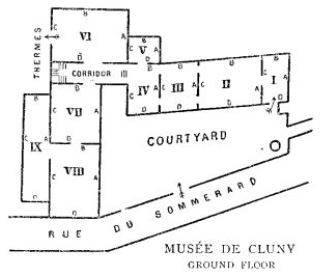
MUSÉE DE CLUNY GROUND FLOOR
Go to the Place du Châtelet; cross the bridge, and the Île de la Cité; also, the Pont St. Michel to the South Side. Good view of Notre-Dame to L. In front lies the modern Boulevard St. Michel, with the Fontaine St. Michel in the foreground (statue by Duret). Continue along the Boulevard till you reach the Boulevard St. Germain, another great modern thoroughfare which cuts right through the streets of the old Faubourg and the narrow alleys of the Latin Quarter. The Garden at the corner contains all that remains of the Roman Palace. Notice its solid masonry as you pass. Then, take the first turn to the L, the Rue du Sommerard, which leads you at once to the door of the Museum.
Notice the late semi-Gothic Gateway, resembling that of an Oxford college. Pass through the flat-arched gate into the handsome courtyard. To the L is a late Gothic loggia, containing a few antiques. In front stands the main building, with square windows and high dormers, bearing the staff and pilgrim’s scallop, the symbol of St. James, with the cardinal’s hat and scutcheons and devices of the family d’Amboise, thus indicating the name of Jacques d’Amboise, the abbot who built it. Entrance to the R. Open free, daily, 11 to 4 or 5, except Mondays.
The first suite of rooms which we enter form some of the apartments of the original building. Observe the fine timbered ceilings.
Room I. – Panels, etc., in wood-carving.
Room II. —*Fine French chimney-piece, by Hugues Lallement, dated 1562, representing Christ and the Woman of Samaria at the well, brought from a house at Châlons-sur-Marne. R and L of entrance (wall A on plan), wooden seats, with canopy, holding good Gothic wood-carvings. Notice L of door, a Deposition in the Tomb; (801) Madonna and Child; then, Birth of the Virgin, with St. Anne in a bed; and below, head of a Saint, hollow, intended to contain her skull or relics. Near it (762), decapitation of St. John Baptist, German, 16th century; and (789) Death of the Virgin. R of doorway, three reliquary heads, and (783 and 784) two groups of the Education of the Virgin. Above, several representations of the Circumcision. Wall B, between the windows, (745) quaint reliquary head of St. Mabile, one of St. Ursula’s 11,000 virgins, the hair gilt, Italian, 15th century; near it, Angel of the Annunciation; Madonna and Child; and Flight into Egypt. Fine wooden chests. In the cases, collections of shoes, uninteresting.
Room III. – Wood-carvings, more or less Gothic. Wall A, (788) Madonna supporting the dead Christ, under a canopy, 16th century; (816) Holy Women, with small figure of the donor, kneeling. (709) large carved altar-piece, end of 15th century; in the centre, Crucifixion, with quaintly brutal Roman soldiers, fainting Madonna, and Holy Women in fantastic head-dresses of the period; below, Nativity, and Adoration of the Magi; L side, above, Flagellation, with grotesquely cruel soldiers; beneath it, angels displaying the napkin of St. Veronica; R side, above, Deposition in the Tomb; beneath it, angels supporting the instruments of the Passion – a splendid piece of Flemish carving. Above, two statues of St. George. Further on (712), votive triptych against the plague, Flemish, carved, with painted flaps on the doors; L, St. Sebastian, with arrows of the pestilence; R, St. Roch exhibiting his plague-spot, with angel who consoled him and dog who fed him (see the legend in Mrs. Jameson); centre, Adoration of the Magi; the Three Kings represent (as usual) the three ages of man, and also the three old continents, Europe, Asia, Africa; hence the youngest king is represented as a Moor. Other episodes (Flight into Egypt, Return of Magi, etc.), in the background – late 15th century. Wall B, first window, stained glass, German panes, 15th century, Annunciation, in two panels (1960 and 1957). Beyond it (830), in woodwork, 16th century, Coronation of the Virgin by Christ and God the Father – a somewhat unusual treatment. Above (758), Stem of Jesse, representing the descent of Christ; notice David with his harp and other kings of Israel; late 15th century. Second window (1958 and 1959), St. Hubert and St. Lambert, companions to the Annunciation; (721) dainty little Crucifixion (16th century), in coloured German wood-carving; (1686) Flemish painting, school of Van Eyck, Crucifixion. Wall D, windows (1961 and 1962), St. Peter and St. George; (1963 and 1964) St. Hubert, and St. Antony Abbot (with his pig, staff, and bell). Wall C, altar-piece, unnumbered; subjects much as opposite; centre, Crucifixion; beneath it, Nativity, Adoration of Magi. L, Way to Calvary (with grotesquely brutal soldiers); beneath it, Annunciation (notice the prie-dieu, book, and bed in the background), and Visitation; R, Descent from the Cross, with St. John and the Marys; beneath it, Circumcision, and Presentation in the Temple. (710) Deposition from the Cross, very good, with painted wings from the Passion. All the wood-carvings in this room deserve careful attention. Inspect them all, and, as far as possible, discover their subjects.
Room IV. – Fine Renaissance chimney-piece, by Hugues Lallement, 16th century, representing Actæon transformed into a stag by Diana, whom he has surprised in the act of bathing. (Subjects from the myth of Diana are favourites with the French Renaissance artists, owing to the influence of Diane de Poitiers.) From Châlons-sur-Marne, same house as that in Room II. Wall A (1779 and 1778), Renaissance classical paintings, part of a large series continued elsewhere; (1428) fine Renaissance carved cabinet (Diana and Chimæras); contrast this and neighbouring Renaissance work with the mediæval carvings in adjacent rooms. Wall B (6329), quaint old Flemish tapestry, representing the Angels appearing to the Shepherds; the Nativity; the Adoration of the Magi; and the Agony in the Garden. Study the arrangement of all these figures, which are conventional, and will reappear in many other examples of various arts. Wall C, R and L of fireplace, good Renaissance wood-carving. Wall D, fine cabinets. In the cases, medals.
Room V, to the side. Debased Italian and Spanish work of the 17th and 18th centuries. Centre, Adoration of the Magi, a meretricious Neapolitan group of the 17th century, intended to place in a church as a Christmas berceau. The costumes of the Three Kings, representing the three continents, the ruined temple in which the action takes place, and the antique statue in the background of the Madonna and St. Joseph, should all be noticed. Contemptible as a work of art, this florid composition of dolls is interesting and valuable for its spirited arrangement, and for the light it casts on the conception of the subject. The room also contains other similar church furniture of the 17th and 18th centuries. Observe their theatrical tinsel style and their affected pietism, as contrasted with the simplicity, naïveté, and truth of earlier periods. Take, as an extreme example of this tendency, the relief of the Annunciation on Wall D, to the R of the entrance door, and compare it with examples of the same subject in other rooms of the collection. Wall B, facing the entrance, good case of miscellaneous woodwork containing excellent Spanish art of this bad period – a Last Supper, a St. Francis receiving the Stigmata, a Massacre of the Innocents, the Faint of St. Catherine, St. Antony the Abbot, St. Antony of Padua carrying the infant Christ, and other figures. A large gilt tabernacle, on Wall C, also contains a debased figure of St. Anthony of Padua, from an altar dedicated to the Saint. Identify as many of these saints as possible, and remember their symbols.
We now quit the older suite of apartments, and enter a large central glass-covered court – Room VI, entirely modern. The Corridor is occupied by early altar paintings, for the most part of little value. Notice on the L, by the staircase (1701), a Giottesque Madonna and Child – Florentine, 15th century. Near it (1666), two oval panels, representing the Annunciation, divided (as frequently happens with this subject) into two distinct portions, and probably flanking a doorway in their original position – Italian, 14th century. All the paintings on this wall, mostly unsatisfactory as works of art, are valuable for their symbolism and the light they throw on the evolution of their subjects. For example: (1676), between the Annunciation pictures, represents the distribution of holy wine which has touched the relics (I think) of St. Hubert. Further on, we have a group of six Apostles; beginning from the R, St. Peter with the keys, St. John Evangelist with the cup and serpent, St. Andrew with his cross, St. Bartholomew with his knife, St. James the Greater with the pilgrim’s staff and scallop, and St. James the Less with a crosier and book. R of the staircase is a stone figure of St. Denis bearing his head, French, 15th century; also, a good statue of the Madonna, a little later. Above the doorway, R, are portions of a large Spanish altar-piece; in the centre, the Crucifixion; extreme R, Assumption of the Virgin, etc. Beyond it comes the continuation of the tabernacle already noticed, containing the six remaining Apostles, with the symbols of their martyrdom. Next, a fine Spanish altar-piece of the 15th century, from a church of St. Martin; in the centre, St. Martin dividing his cloak with the beggar; round it various other subjects, among them St. Antony with his pig, St. Stephen, in deacon’s robes, with the stones of his martyrdom, St. Jerome in the desert beating his bosom with a flint before the crucifix, St. Francis displaying the stigmata or five wounds of Christ, St. Paul the hermit with his lion, etc. R, towards the courtyard, a fine figure of Adam from St. Denis, a splendid example of the best French nude sculpture of the 14th century.
We now enter the covered courtyard or Room VI proper, filled with fine examples of French mediæval sculpture. Several of the objects bear labels sufficiently descriptive. I will therefore only call attention to a few among them. Wall D, two wooden Flemish statues (Our Lady and St. John at Calvary), R and L of the doorway; (417) carved marble monument of the 10th or 11th century; very fine workmanship, with distinct reminiscences of the antique. Wall A, *Magnificent stone frieze or reredos, originally gilt and coloured, representing the History of St. Benedict, from St. Denis; in the centre, Baptism in Jordan (compare the relief of the same subject in Notre-Dame); R and L, preaching and miracles of St. Benedict (overthrow of idols, cure of a dying woman). Middle of wall (6328), fine Italian tapestry, 16th century, representing the Adoration of the Magi; observe the attitude of the kings, together with the ox and ass in the background, invariable concomitants of the Nativity in art. Beneath (728), early wooden Madonna (13th century, Auvergne), with Byzantine aspect. Beautiful Romanesque capitals – Creation of Eve, etc. Wall B*(237), exquisite stone frieze or reredos from the church of St. Germer, about 1259, much-mutilated, but originally one of the most perfect specimens of French 13th century carving; it still betrays traces of colour. In the centre, Crucifixion, with Virgin and St. John: on either side (as at Notre-Dame), the Church, with cross and chalice, and the Synagogue, with eyes blinded: then, R and L of cross, St. Peter and St. Paul: beyond them, Annunciation and Visitation: finally, L, St. Ouen, uncle of St. Germer, cures a wounded warrior; R, St. Germer asks leave of King Dagobert to found the Abbey from which this came. Above it (509), exquisitely grotesque relief of the Resurrection with sleeping Roman soldiers, one of a set in alabaster, French 14th century (500 to 512), all of which deserve to be inspected; meanings of all are obvious except (501) St. Ursula. Still higher, fragment of the original Last Judgment on the central west door of Notre-Dame, Paris, before the restoration – interesting as showing the grounds on which Viollet-le-Duc proceeded; (6322), tapestry, Arras, 15th century, various scriptural subjects, confused, but decipherable. Beneath it, L, *beautiful stone relief (reredos) of the legend of St. Eustace, from the church of St. Denis – a fine French work of the 14th century. In the centre, Crucifixion; extreme L, St. Eustace, hunting, is converted by the apparition of the Christ between the horns of the stag he is pursuing; further R, his baptism, nude, in a font, as in all early representations; still further R, his trials and history; while he crosses a river with one of his children, a wolf seizes one, while a lion devours the other; last of all, reunited miraculously with his family, he and they are burned alive as martyrs by the Emperor Trajan, in a brazen bull. Observe naïf boy with bellows. The whole most delicately and gracefully sculptured. Next, coloured stone relief of the Passion – French 14th century; subjects, from R to L: the kiss of Judas (observe Peter drawing the sword); Flagellation; Bearing of the Cross, with Simon of Cyrene; Deposition in the Tomb; Resurrection; and Christ in Hades, delivering Adam and Eve from the jaws of death, realistically represented here and elsewhere as the mouth of a monster; notice in this work the colour and the Gothic architecture and decoration of the background, which help one to understand features that are missing in many other of these reredoses. Then, stone relief of the Annunciation, Visitation, and Nativity, very simply treated: notice the usual ox and ass in the manger. Above it, *(4763), good mosaic of the Madonna and Child with adoring angels, by Davide Ghirlandajo, of Florence, placed by the President Jean de Ganay (as the inscription attests) in the church of St. Merri at Paris. Wall C (513–518), interesting alabaster reliefs of the Passion, French, 14th century. Between them, Coronation of the Virgin, French, 15th century. (725) Good wooden figure of St. Louis, covered with fleur-de-lis in gold, from the Sainte Chapelle. [Here is the door which leads to the Musée des Thermes. Pass it by for the present.] Beyond it, continuation of the alabaster reliefs (514 and 517), etc.: examine them closely. Between them (435), Circumcision, in marble, early 15th century, French, full of character. Beneath it (429, etc.), admirable figures of mourners, from the tomb of Philippe le Hardi, at Dijon, 14th century. Wall D, again (1291), terra-cotta, coloured: Madonna and St. Joseph, with angels, adoring the Child (child missing), ox and ass in background; R, Adoration of Magi; notice once more the conventional arrangement: L, Marriage of the Virgin, a high priest joining her hand to Joseph’s, all under Gothic canopies, 15th century, from the chapel of St. Éloy, near Bernay, Eure. I omit many works of high merit.



